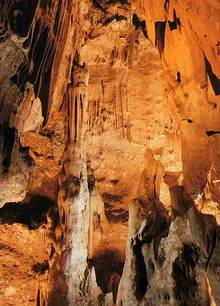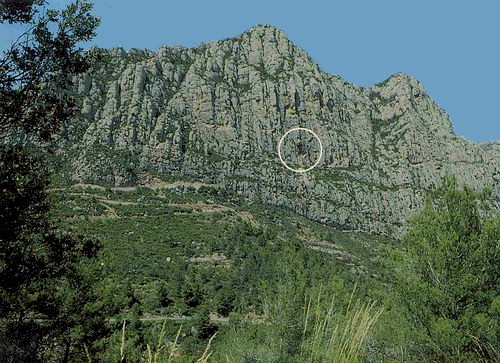Les Coves del Collbató
 The
Coves del Collbató are located at Montserrat, a short journey (40 minutes) to
the north of Barcelona. The
Coves del Collbató are located at Montserrat, a short journey (40 minutes) to
the north of Barcelona.
The Collbató caves, revealed through exploitation of sodium
nitrate deposits, are found within the Montserrat massif, part of the Catalan
pre-coastal range, and date from the Tertiary era. Differential erosion and
weathering of this massif has led to the highly distinctive relief features that
can be seen in the photograph that forms the background to this page.
The massif was once a delta of several rivers draining into a
shallow inland sea, occupying what is today the Central Catalan Depression. The
rivers deposited coarse, heavy, well-rounded stones and cobbles, which become
finer towards the south of the massif, demonstrating characteristic deltaic
sorting.
During the Oligocene era, the elevation of the land during the
period that built the Alpine and Pyrenean mountain ranges led to the creation of
an inland lake. Earth movements led to jointing of the rock which has had a
decisive influence upon the present day relief.
The pressure of overlying sedimentary layers and earth
movements created great heat which melted the skeletal remains of sea and lake
organisms that had accumulated in huge quantities. This calcite ooze formed a
strong cement binding together the stone and cobble deposits to create the
conglomerate we see today. This is spectacularly revealed inside the caves.
The natural limestone of the conglomerates has been slowly
dissolved by rainwater, infiltrating the rock through the joints before meeting
layers of impermeable clay. The general underground drainage direction is north
and north east, following the dip of the rock strata. This explains the
polarization of strangely carved outcrops to the north of Montserrat.
The underground limestone scenery is found above the water
table, particularly to the south of the massif. The caves at Collbató served as
an underground drain feeding an ancient valley of the Salut torrent (now
excavated by the Llobregat river). Two different stages of the development of
the water level can be identified in the Pou del Diable pothole inside the
caves.
The caves are not as accessible as most, and involve a 20
minute walk up a path that is well protected, but steep in places.

Brief description of the Caves
The caves are always a constant temperature of 14º, with a
relative humidity of 97%.
La Cova de la Cathedral
This is some 60 metres in length and 35 metres in height, with
walls formed of great conglomerate blocks and contains a small lake.
El Pou del Diable
This contains spectacular formations of stalactites and
stalagmites on a grand scale. The natural 25-30º strike of the rock strata
(dipping to the NE) can be clearly seen.
La Cova del Cambril o Columnes
This is possibly the most spectacular of all the caves, rich in
stalactite columns, with a slope indicating the exit of water towards the south
east.
|